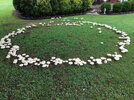Jtucker
Jedi Master
I discovered these rings of spruce trees on Google Earth a few years ago while looking for geographical features and hiking trails near Spruce Woods Provincial Park (Manitoba) where we camped a few times over the years.
Co-ordinates:
49.41.25 N
99.10.05 W
Elevation - 324 M
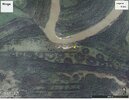
This location isn't hard to reach as it's only a 5 minute drive from the campground and there are equestrian trails leading right up to them. From the ground the rings just look like clusters of spruce in a meadow.
The circles are quite large and in a very unusual pattern (see the scale in the lower right hand corner). They sit below the level of the meadow in depressions that have thick vegetation underlying the trees as well. The surrounding meadow land is very sparsely vegetated and quite open.
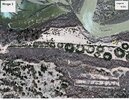
I enhanced the image above with contrast to get a better look. Also note the strange rectilinear structure below the rings. It looks to be about 400 metres long. We couldn't get close enough to that to get a good look as there was a fence line blocking it. There was also a lot of coyote scat and tracks which we weren't comfortable having our dogs around for too long as they could end up as lunch.
In terms of the rings, I don't think there's any likelihood their man-made as they don't seem to have any purpose. Conceivably they may have been planted that ways decades ago (the trees are very large) to prevent bank erosion as the Assiniboine River floods regularly. But that seems unlikely as there are no farms or farm land anywhere near there and the banks are 70 feet high off the river. Also the worst flooding is upstream and has wiped out the park and HWY 5 in the past 20 years, so protecting this area makes no sense.
As for the rectilinear pattern, I have no idea what that is. There were a number of fur trade forts in the general area from the 1760's, but none recorded within 20 km of this location and it would not make sense to have one on such a steep area. It's also a much larger structure than any of the Forts would have had at that time. It may not even be a remnant of a structure, but just more tress growing in an unusual pattern.
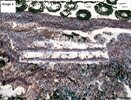
After watching some Randall Carlson on the potential impact at Glacial Lake Hind (50km to the SW), I'm thinking that an impact (wether that one or another) may have left some unusual soil deposits deep enough in the sand to keep a healthy tree population fed for centuries? Or an unusual energetic EM profile? Below is a larger image of the whole area.

The Assiniboine Delta Fan looks like a huge mud flow coming down towards the river. But's actually all sand. It's referred to as Spirit Sands Trails and is an anomaly in the area. The volume of sand is so huge that the ecosystem has remained a desert island surrounded by this woods. We've hiked it twice and it's an actual desert. Hiking in sand is exhausting when you haven't done it before. You need to carry a lot of water if you hike in the summer (we made that mistake, thinking it's not a real desert).
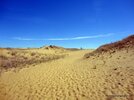
Does anyone have any idea what the rings or the rectilinear structure might be?
Co-ordinates:
49.41.25 N
99.10.05 W
Elevation - 324 M

This location isn't hard to reach as it's only a 5 minute drive from the campground and there are equestrian trails leading right up to them. From the ground the rings just look like clusters of spruce in a meadow.
The circles are quite large and in a very unusual pattern (see the scale in the lower right hand corner). They sit below the level of the meadow in depressions that have thick vegetation underlying the trees as well. The surrounding meadow land is very sparsely vegetated and quite open.

I enhanced the image above with contrast to get a better look. Also note the strange rectilinear structure below the rings. It looks to be about 400 metres long. We couldn't get close enough to that to get a good look as there was a fence line blocking it. There was also a lot of coyote scat and tracks which we weren't comfortable having our dogs around for too long as they could end up as lunch.
In terms of the rings, I don't think there's any likelihood their man-made as they don't seem to have any purpose. Conceivably they may have been planted that ways decades ago (the trees are very large) to prevent bank erosion as the Assiniboine River floods regularly. But that seems unlikely as there are no farms or farm land anywhere near there and the banks are 70 feet high off the river. Also the worst flooding is upstream and has wiped out the park and HWY 5 in the past 20 years, so protecting this area makes no sense.
As for the rectilinear pattern, I have no idea what that is. There were a number of fur trade forts in the general area from the 1760's, but none recorded within 20 km of this location and it would not make sense to have one on such a steep area. It's also a much larger structure than any of the Forts would have had at that time. It may not even be a remnant of a structure, but just more tress growing in an unusual pattern.

After watching some Randall Carlson on the potential impact at Glacial Lake Hind (50km to the SW), I'm thinking that an impact (wether that one or another) may have left some unusual soil deposits deep enough in the sand to keep a healthy tree population fed for centuries? Or an unusual energetic EM profile? Below is a larger image of the whole area.

The Assiniboine Delta Fan looks like a huge mud flow coming down towards the river. But's actually all sand. It's referred to as Spirit Sands Trails and is an anomaly in the area. The volume of sand is so huge that the ecosystem has remained a desert island surrounded by this woods. We've hiked it twice and it's an actual desert. Hiking in sand is exhausting when you haven't done it before. You need to carry a lot of water if you hike in the summer (we made that mistake, thinking it's not a real desert).

Does anyone have any idea what the rings or the rectilinear structure might be?



